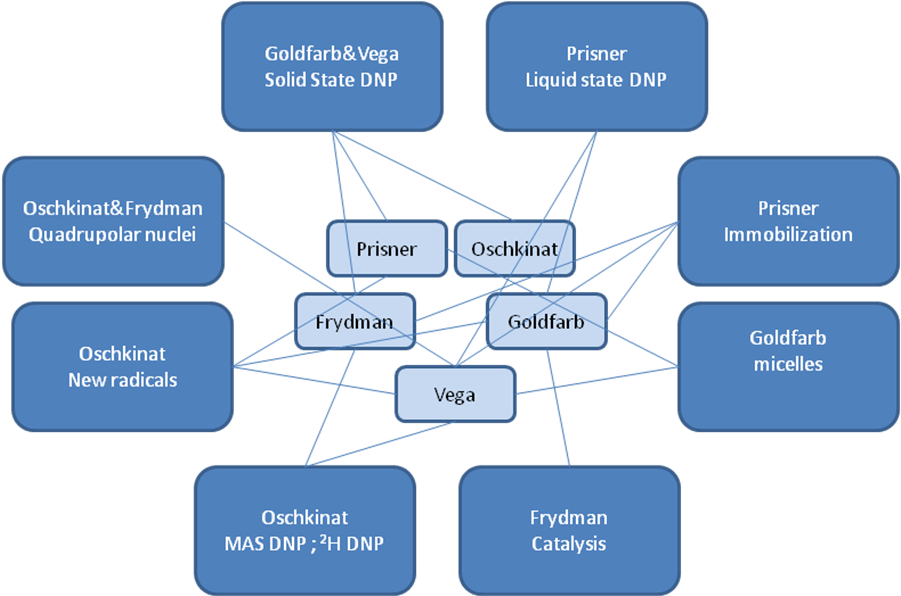
home > research > DNP-DIP
Dynamic Nuclear Polarization:
Integrating Fundamentals and New Applications
DIP: German-Israeli's Project (DIP-DNP/DFG)
List of project partners
Prof. Lucio Frydman, Chemical Physics Department, Weizmann Institute of Science, Rehovot, Israel
Prof. Daniella Goldfarb, Chemical Physics Department, Weizmann Institute of Science, Rehovot, Israel
Prof. Hartmut Oschkinat, Department of NMR-Supported Structural Biology, Leibnitz Institute for Molecular Pharmacology, Berlin, Germany.
Prof. Shimon Vega, Chemical Physics Department, Weizmann Institute of Science, Rehovot, Israel
1) INTRODUCTION
An important recent development in nuclear magnetic resonance (NMR) and magnetic resonance imaging (MRI) has been the advent of dynamic nuclear polarization (DNP) approaches. DNP overcomes the inherently low sensitivity of magnetic resonance methods by creating nuclear polarizations that depart from their usual ppm thermal values and can approach unity under certain conditions. This occurs by virtue of the use of stable radicals capable of transferring their high polarization to the nuclear.
Liquid DNP
Undoubtedly, enhancement of the nuclear polarization is of direct significance for the characterization of large biomolecules using nuclear magnetic resonance (NMR). From that perspective, it becomes highly desirable to develop the necessary technology for performing DNP under conditions appropriate for biomolecular NMR, namely at high magnetic fields and in aqueous solutions. The high magnetic fields employed in biomolecular NMR studies render the technological aspect of the corresponding DNP experiments particularly challenging. In the framework of a EU-Design study (2006-2009) the potential to use DNP directly in the liquid phase at high magnetic fields was explored. The goal was to experimentally measure the field dependence of the Overhauser DNP enhancement up to high magnetic fields. This was done for the first time for an extensive magnetic field range from 0.1 T up to 10 T. The first liquid-state DNP experiments at 3.4 and 9.2 Tesla reported enhancements as large as -20 and -11, respectively, for the nuclear magnetization of water protons by small nitroxide radicals. These results indicate that enhancements of significant practical interest are achievable even at such high fields.
2) RESEARCH OBJECTIVES
Investigation of the origin of liquid DNP at high fields
The group of Prof. Prisner will focus on the development of direct DNP in liquids aiming at biomolecual NMR applications, focusing on instrumental, methodological and theoretical aspects. In order to get a better understanding of the mechanism at high fields it is now necessary to determine the effects of the relaxation parameters and sample compositions on the enhancement. EPR and NMR experiments will be conducted to establish these dependences and new theoretical tools will be developed. In addition an extra effort will be made to derive spin relaxation parameters of liquids at high fields by using MD calculations.
3) RESEARCH DESPRIPTION
The physical origins of Overhauser DNP in liquids at high magnetic fields
As explained in the introduction a detailed understanding of the substantial DNP enhancements obtained in liquid samples at high magnetic fields is missing. We obtain momentarily at our home built 10 T DNP spectrometer enhancements up to -80 (see the picture below) This value is order of magnitude larger than predicted based on translational and rotational diffusion of the radical and water molecules. To understand these large enhancements we have to systematically investigate and differentiate the saturation behaviour, the coupling factor and possible contributions from coherent pathways. Molecular dynamic (MD) studies will be carried out to help to understand the dependence of the coupling factor on the radical, solvent molecule and temperature.

4) SUMMARY OF COLLABORATIONS

Flow diagram indicating the collaborations of this joint Research Plan
| Last modified: February 19, 2014 | Impressum / About / Legal Notice | Datenschutzerklärung |
Prisner LOGS
Webmail
Internal
|